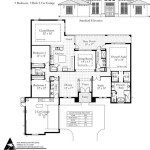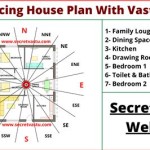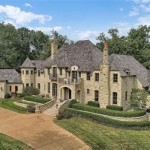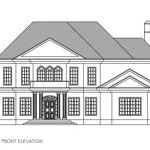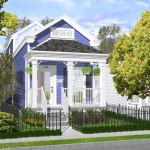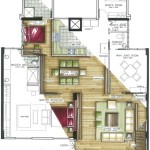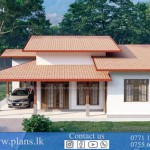```html
Cabin Floor Plan Ideas: Designing Your Ideal Retreat
Cabin floor plans represent a unique challenge and opportunity for architects and homeowners alike. The objective is to create a functional and aesthetically pleasing space, often within a smaller footprint, that harmonizes with the natural environment. Efficient use of space, integration of natural light, and prioritization of key living areas are crucial considerations. This article will explore various aspects of cabin floor plans, focusing on design ideas that cater to different needs and preferences.
Prioritizing Functionality in Small Spaces
One of the primary considerations when designing a cabin floor plan is optimizing functionality within a limited area. Cabins are frequently smaller than traditional homes, typically ranging from a few hundred to a thousand square feet. Consequently, every square inch must be utilized effectively. Multifunctional furniture and open-plan living areas are commonly employed to maximize the perceived and actual space.
Open-plan layouts combine the living room, dining area, and kitchen into a single, cohesive space. This arrangement promotes a sense of spaciousness and allows for easy interaction between occupants. To define individual zones within the open plan, strategic placement of furniture, changes in flooring material, and the use of area rugs can be effectively employed. For example, a kitchen island can serve as a visual and functional barrier between the kitchen and the living area, providing additional counter space and seating.
Multifunctional furniture plays a critical role in maximizing space efficiency. Sleeper sofas, futons, and Murphy beds provide sleeping accommodations without occupying permanent floor space. Storage ottomans, coffee tables with hidden compartments, and dining benches with built-in storage offer discreet storage solutions. Wall-mounted shelves and cabinets help to keep clutter off the floor, contributing to a cleaner and more organized aesthetic.
Vertical space is often underutilized in small cabins. Tall ceilings, where feasible, create a sense of airiness and allow for the incorporation of loft areas. Lofts can serve as sleeping quarters, reading nooks, or storage spaces. Alternatively, vertical storage solutions, such as floor-to-ceiling shelving units, can maximize storage capacity without consuming valuable floor space.
Integrating Natural Light and the Outdoors
A defining characteristic of cabin living is the connection to nature. Maximizing natural light and integrating the outdoors into the cabin design are essential elements of a successful floor plan. Large windows, strategically placed skylights, and expansive decks or porches facilitate this connection.
Large windows not only provide ample natural light but also offer panoramic views of the surrounding landscape. Picture windows, which are large, fixed-pane windows, are particularly effective at framing scenic vistas. Casement windows, which crank open outward, provide excellent ventilation. Strategically positioning windows to capture morning or afternoon sunlight enhances the cabin's overall ambiance and reduces the need for artificial lighting during the day.
Skylights are an excellent option for introducing natural light into areas where traditional windows are not feasible, such as hallways or bathrooms. They can also be used to illuminate the center of a cabin with a high ceiling. Operable skylights, which can be opened and closed, provide ventilation and allow for natural airflow.
Decks and porches serve as transitional spaces between the interior and exterior environments. They extend the living area outdoors and provide opportunities for relaxation, dining, and enjoying the surrounding scenery. A covered porch offers protection from the elements, allowing for year-round enjoyment. Consider incorporating built-in seating or an outdoor fireplace to create a cozy and inviting outdoor space.
French doors or sliding glass doors seamlessly connect the interior living space to the deck or porch. These doors provide easy access to the outdoors and allow for abundant natural light and ventilation. When open, they blur the boundaries between the indoor and outdoor environments, creating a sense of spaciousness and openness.
Designing for Specific Needs and Preferences
Cabin floor plans should be tailored to the specific needs and preferences of the occupants. Considerations include the number of people who will be using the cabin, the intended use of the cabin (e.g., weekend retreat, full-time residence), and any specific lifestyle requirements. Different floor plan layouts can accommodate diverse needs.
For a small family or couple, a one-bedroom cabin with an open-plan living area and a well-equipped kitchen may suffice. The bedroom can be designed as a private retreat, with ample storage and a comfortable sleeping area. If occasional guests are expected, a sleeper sofa in the living room can provide additional sleeping accommodations.
Larger families or groups may require a two- or three-bedroom cabin. In this case, the floor plan should be carefully designed to ensure privacy and personal space for each occupant. Separate bedrooms, multiple bathrooms, and a larger living area are typically necessary. Consider incorporating a bunk room for children or a guest suite for visitors.
Individuals who plan to use the cabin as a full-time residence may need to consider additional factors, such as laundry facilities, ample storage, and a dedicated workspace. A mudroom or entry area can help to keep dirt and debris from being tracked into the main living area. A well-insulated cabin with efficient heating and cooling systems is essential for year-round comfort.
Individuals with mobility limitations may require a cabin floor plan that is accessible and adaptable. Wider doorways, ramps instead of stairs, and accessible bathrooms are important considerations. A single-story cabin is generally more accessible than a multi-story cabin. Universal design principles, which aim to create spaces that are usable by people of all ages and abilities, can be incorporated into the design to ensure accessibility and inclusivity.
The orientation of the cabin on the property can significantly impact the floor plan design. Consider the direction of sunlight, prevailing winds, and views when determining the optimal placement of the cabin. Orienting the cabin to maximize sunlight exposure during the winter months can help to reduce heating costs. Conversely, orienting the cabin to minimize sunlight exposure during the summer months can help to keep the cabin cool.
The overall aesthetic of the cabin should reflect the personal tastes and preferences of the occupants. Rustic, modern, and traditional cabin styles each have their own unique characteristics. Rustic cabins often feature exposed beams, wood paneling, and natural stone accents. Modern cabins tend to be more streamlined and minimalist, with clean lines and large windows. Traditional cabins typically incorporate classic architectural elements and comfortable furnishings.
Choosing sustainable and eco-friendly materials can minimize the environmental impact of the cabin. Reclaimed wood, recycled metal, and energy-efficient appliances are all excellent options. Consider incorporating passive solar design principles, such as strategic window placement and overhangs, to reduce energy consumption. A well-insulated cabin can significantly reduce heating and cooling costs and create a more comfortable living environment.
```
10 Bedroom Log Cabin Floor Plans Ideas House Home

Small Cabin Plan With Loft House Plans

Cabin Floor Plan Log Home Plans House Homes

Taylor Log Cabin Floor Plans Small
Small Cabin House Plans With Loft And Porch For Fall Houseplans Blog Com

Small Cabin Designs With Loft Floor Plans

Small Cottage Floor Plan With Loft Designs

Rustic Vacation Homes Simple Small Cabin Plans Houseplans Blog Com

Because Of Their Rustic Look And Generally Straightforward Layout Log Cabins Go Hand In With Simplici Cabin Floor Plans House

Small Cabin House Plans Floor Construction

